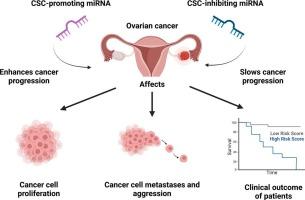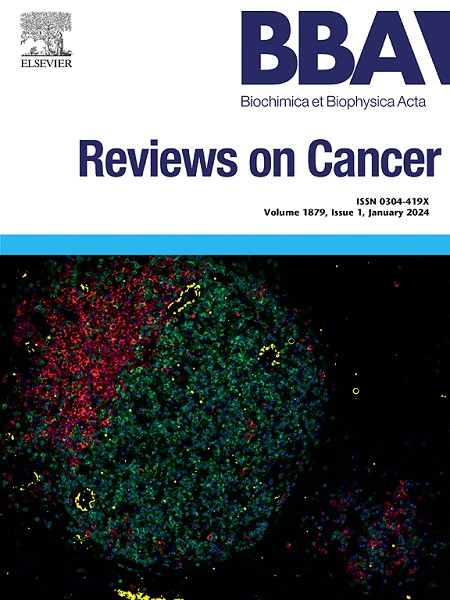Roles of miRNAs in regulating ovarian cancer stemness
IF 9.7
1区 医学
Q1 BIOCHEMISTRY & MOLECULAR BIOLOGY
Biochimica et biophysica acta. Reviews on cancer
Pub Date : 2024-09-29
DOI:10.1016/j.bbcan.2024.189191
引用次数: 0
Abstract
Ovarian cancer is one of the gynaecology malignancies with the highest mortality rate. Ovarian cancer stem cell (CSC) is a subpopulation of ovarian cancer cells with increased self-renewability, aggression, metastatic potentials, and resistance to conventional anti-cancer therapy. The emergence of ovarian CSC is a critical factor that promotes treatment resistance and frequent relapse among ovarian cancer patients, leading to poor clinical outcomes. MicroRNA (miRNA) is a short, non-protein-coding RNA that regulates ovarian CSC development. Although multiple original research articles have discussed the CSC-regulatory roles of different miRNAs in ovarian cancer, there is a deficiency of a review article that can summarize the findings from different research papers. To narrow the gap in the literature, this review aimed to provide an up-to-date summary of the CSC-regulatory roles of various miRNAs in modulating ovarian cancer cell stemness. This review will begin by giving an overview of ovarian CSC and the pathways responsible for driving its appearance. Next, the CSC-regulatory roles of miRNAs in controlling ovarian CSC development will be discussed. Overall, more than 60 miRNAs have been reported to play CSC-regulatory roles in the development and progression of ovarian cancer. By targeting various downstream targets, these miRNAs can control the signaling activities of PI3K/AKT, EGFR/ERK, WNT/ß-catenin, NF-kß, Notch, Hippo/YAP, EMT, and DNA repair pathways. Hence, these CSC-modulatory miRNAs have the potential to be used as prognostic biomarkers in predicting the clinical outcomes of ovarian cancer patients. Targeting CSC-promoting miRNAs or increasing the expressions of CSC-repressing miRNAs can help slow ovarian cancer progression. However, more in-depth functional and clinical trials must be carried out to evaluate the suitability, safety, sensitivity, and specificity of these CSC-regulating miRNAs as prognostic biomarkers or therapeutic targets.

miRNA 在调节卵巢癌干性中的作用
卵巢癌是死亡率最高的妇科恶性肿瘤之一。卵巢癌干细胞(CSC)是卵巢癌细胞的一个亚群,具有更强的自我更新能力、侵袭性、转移潜力和对传统抗癌疗法的抵抗力。卵巢癌干细胞的出现是导致卵巢癌患者耐药和频繁复发的关键因素,从而导致不良的临床预后。微小RNA(miRNA)是一种短小的非蛋白编码RNA,可调控卵巢CSC的发展。虽然已有多篇原创研究文章讨论了不同 miRNA 在卵巢癌中的 CSC 调控作用,但目前还缺少一篇综述文章来总结不同研究论文的发现。为了缩小文献空白,本综述旨在对各种 miRNA 在调节卵巢癌细胞干性中的 CSC 调节作用进行最新总结。本综述将首先概述卵巢干细胞及其出现的驱动途径。接下来,将讨论 miRNA 在控制卵巢 CSC 发展中的 CSC 调节作用。据报道,共有 60 多种 miRNA 在卵巢癌的发生和发展过程中发挥着 CSC 调节作用。通过靶向各种下游靶点,这些miRNA可控制PI3K/AKT、EGFR/ERK、WNT/ß-catenin、NF-kß、Notch、Hippo/YAP、EMT和DNA修复通路的信号活性。因此,这些可调节造血干细胞的 miRNA 有可能被用作预测卵巢癌患者临床结局的预后生物标志物。靶向促进 CSC 的 miRNAs 或增加抑制 CSC 的 miRNAs 的表达有助于减缓卵巢癌的进展。然而,要评估这些调节 CSC 的 miRNA 作为预后生物标志物或治疗靶点的适宜性、安全性、敏感性和特异性,还必须进行更深入的功能和临床试验。
本文章由计算机程序翻译,如有差异,请以英文原文为准。
求助全文
约1分钟内获得全文
求助全文
来源期刊

Biochimica et biophysica acta. Reviews on cancer
医学-生化与分子生物学
CiteScore
17.20
自引率
0.00%
发文量
138
审稿时长
33 days
期刊介绍:
Biochimica et Biophysica Acta (BBA) - Reviews on Cancer encompasses the entirety of cancer biology and biochemistry, emphasizing oncogenes and tumor suppressor genes, growth-related cell cycle control signaling, carcinogenesis mechanisms, cell transformation, immunologic control mechanisms, genetics of human (mammalian) cancer, control of cell proliferation, genetic and molecular control of organismic development, rational anti-tumor drug design. It publishes mini-reviews and full reviews.
 求助内容:
求助内容: 应助结果提醒方式:
应助结果提醒方式:


